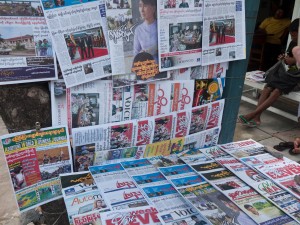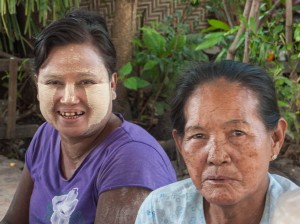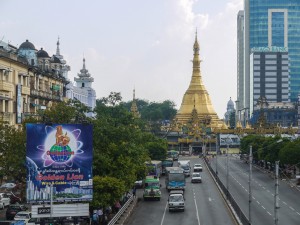Myanmar’s ethnic media finding its voice, but faces hurdles

Myanmar’s media sector has opened up remarkably over the past few years (photo: Kyle James)
The country of Myanmar is a complicated patchwork of ethnic groups, languages and cultural identities. Ethnic conflict in the country, also known as Burma, existed even before independence in 1948 and increased under the iron-fisted military rule that began in 1962.
In addition, ethnic media was suppressed by the junta, which increased the sense of marginalization felt by over one-third of the population belonging to an ethnic minority.
But as the country has opened up over the past few years, ethnic media publications have begun to appear, speaking to their communities in their own languages and addressing issues relevant to them. Still, there are a good many hurdles in the way of the creation of a flourishing ethnic media sector, as onMedia’s Kyle James found during two recent trips to the Southeast Asian country.
The media landscape in Myanmar has changed dramatically since President Thein Sein assumed office in 2011 and began a series of reforms to open up the long-time pariah state, including loosening restrictions on the media sector and removing draconian censorship laws.
The one-time military government, which came to power in a 1962 coup, had suppressed local media for decades. The junta made the Burmese language, spoken by a majority in the central parts of the country, dominant in politics, education and the media. Even teaching in ethnic languages was banned. The only ethnic-language media people heard was propaganda on the state broadcaster.
Groups who wanted to publish in their own languages had to do it from outside the country. About a dozen ethnic media outlets set up operations abroad to escape government control.
A new day
Things changed dramatically in late December 2012, when the reformist government lifted restrictions on news publication in ethnic languages as part of its reform drive. Many journalists from ethnic groups heralded the decision as a watershed moment in the country’s history and of critical importance to many of the 135 ethnic groups recognized by the government.

Myanmar is enjoying more press freedom than ever, but there are concerns some people are being left out (photoi: Kyle James)
“Ethnic media lets people get information in their own language and it preserves ethnic cultures and traditions, which are in danger of dying out in some places,” Khaing Mrat Kyaw, a director at Burma News International, told me in Yangon. BNI is an umbrella group of ethnic media organizations that got started in 2002. Based in Thailand, it was finally able to open up an office in Myanmar in 2012.
Many other journalists and editors I spoke to around the country echoed his statements, saying that ethnic communities needed media in their own language about topics relevant to their own lives and communities – not just news focused on the main cities of Yangon, Mandalay and the new capital, Naypyidaw.
The Myanmar State Based Media Guide 2014 lists just under 50 ethnic outlets in the country. The hope is that these publications can regain the trust of ethnic community members, long eroded by acrimonious relations with the central government.
Local media could help local economic and social development, sorely needed in many areas and play a role in peace-building efforts and reconciliation
“But there are still problems,” Khaing Mrat Kyaw said. “Television and FM radio promote only Burmese culture, even today.”
While coverage of ethnic issues has increased some in the mainstream press recently, it’s still quite limited, journalists said.
High hurdles
In fact, while the heavy hand of the government has been lifted, ethnic media still faces a host of other problems.
Mai Democracy of the Chin World Media Group, which publishes a paper focused on the country’s Chin minority, said people in ethnic areas often simply don’t have much access to media. Bad or even non-existent roads in many areas mean newspapers never reach far-flung communities, or get there days late.

Much media coverage focuses only on a few big cities like Yangon (photo: Kyle James)
“Chin State is very poor. People don’t have time to read the paper or the money to buy it, they’re busy trying to survive,” she said.
In addition, decades of suppression of education in ethnic languages have limited the audience for ethnic publications. Some ethnic newspapers publish in Burmese, since fewer people these days can actually read well in their mother tongue. Education levels in some ethnic areas are very low.
Economic survival is a constant worry for many of these publications, which are often teetering on the edge of insolvency, and sometimes have to shut down until they find new sources of revenue and can start printing again.
It can be hard to sell advertising for ethnic media, who have a hard time competing with government-backed outlets with subsidies and bigger commercial publications. Plus, finding qualified reporters is tough since very few people in Myanmar have any journalistic training beyond maybe the occasional one-off course sponsored by an international NGO or media organization.
Despite the challenges, groups like BNI are working to improve cooperation among ethnic media outlets and get them talking to each other and holding regular conferences.
There’s strength in numbers and networks, the thinking goes. And if more people are talking with one another, sharing strategies and information, it’s more likely that ethnic media can finally take its place at the country’s media table.
Author: Kyle James



